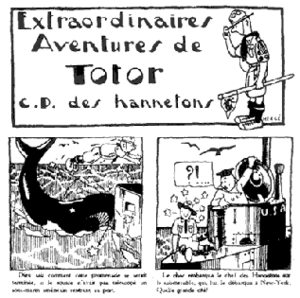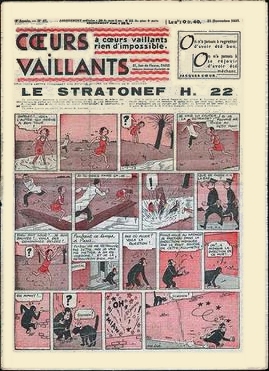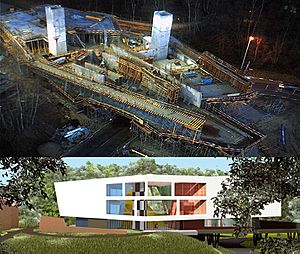Hergé facts for kids
Quick facts for kids Hergé |
|
|---|---|
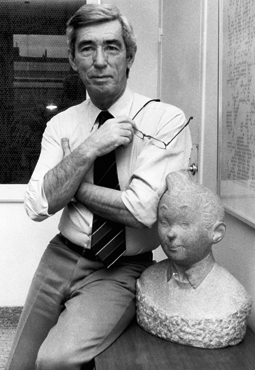
Hergé, with a bust of Tintin
(Sculpture by Nat Neujean) |
|
| Born | Georges Prosper Remi 22 May 1907 Etterbeek, Belgium |
| Died | 3 March 1983 (aged 75) Woluwe-Saint-Lambert, Belgium |
| Area(s) | Cartoonist |
| Pseudonym(s) | Hergé |
|
Notable works
|
|
| Awards | List of awards |
| Spouse(s) |
|
| Signature | |
Georges Prosper Remi (born May 22, 1907 – died March 3, 1983), known by his pen name Hergé, was a famous Belgian cartoonist. He is best known for creating The Adventures of Tintin, a series of comic albums. These comics are considered some of the most popular European comics of the 20th century.
Hergé also created two other well-known comic series: Quick & Flupke (from 1930 to 1940) and The Adventures of Jo, Zette and Jocko (from 1936 to 1957). His drawings were made in his special ligne claire (clear line) style.
Contents
Early life
Georges Prosper Remi was born on May 22, 1907, in Etterbeek, a part of Brussels, Belgium. His family was not rich, but they were not poor either. His father, Alexis Remi, worked in a candy factory, and his mother, Elisabeth Dufour, was a housewife.
Georges grew up speaking French, but he also learned Dutch because Brussels is a bilingual city. He had a younger brother named Paul, who was born five years after him. His family was Roman Catholic, but they were not very strict about their religion. Hergé later said that his early life in Etterbeek felt quite boring.
Georges loved movies, especially films by Charlie Chaplin and Buster Keaton. These films later influenced his comic strips. He also enjoyed reading adventure novels like Huckleberry Finn and Treasure Island.
As a hobby, he loved to draw. He would sketch scenes from his daily life in the margins of his school books. Some of his drawings were of German soldiers because World War I happened during his primary school years, and Brussels was occupied by the German army. He finished school in July 1925, doing very well in his studies.
When he was 12, Remi joined the Boy Scouts. He became a troop leader and was given the name "Curious Fox." With the Scouts, he traveled to places like Italy, Switzerland, Austria, and Spain. These experiences greatly influenced his life, making him love camping and nature. They also taught him about loyalty and keeping promises.
His Scout leader, Rene Weverbergh, saw his talent for drawing. He published one of Remi's drawings in the Scout newsletter, which was Hergé's first published work. Remi continued to publish cartoons and drawings in the Scout newsletter, which was later renamed Le Boy-Scout Belge. During this time, he tried out different pen names before choosing "Hergé." This name came from the French pronunciation of his initials, R.G., but reversed. His work first appeared under the name "Hergé" in December 1924.
Career
Hergé started his career by drawing for Scouting magazines. He created his first comic series, The Adventures of Totor, for Le Boy-Scout Belge in 1926.
In 1929, while working for a newspaper called Le Vingtième Siècle, he created The Adventures of Tintin. The editor, Norbert Wallez, suggested the idea. The series is about a young reporter named Tintin and his dog Snowy. The first stories, like Tintin in the Land of the Soviets and Tintin in the Congo, were very popular. After being published in the newspaper, these stories were released as comic books.
Hergé continued the Tintin series and also created Quick & Flupke and Jo, Zette and Jocko for Le Vingtième Siècle. From 1934, influenced by his friend Zhang Chongren, Hergé started doing much more research for his stories. This made his comics, starting with The Blue Lotus, much more realistic.
During World War II, Belgium was occupied by Germany. Le Vingtième Siècle was closed, but Hergé continued his Tintin series in Le Soir, a popular newspaper that was controlled by the German administration.
After the war ended in 1944, Le Soir was shut down. Hergé and others who worked there were questioned about their work during the occupation. An official investigation was started, but no charges were ever brought against Hergé. However, he sometimes faced questions about his actions during the war in later years.
In 1946, Hergé, along with Raymond Leblanc, started Tintin magazine. He published new Tintin stories there. As the magazine's artistic director, he also helped publish other successful comics, like Edgar P. Jacobs' Blake and Mortimer.
In 1950, Hergé created Studios Hergé. This was a team of artists who helped him with his projects. Important team members like Jacques Martin and Bob de Moor helped a lot with later Tintin books. During a difficult time in his personal life, he created Tintin in Tibet, which he considered his favorite work.
Hergé's comics are praised for their clear drawings and detailed, well-researched plots. His works have been made into plays, radio shows, TV shows, movies, and even computer games. He is still a big influence on comic books, especially in Europe. In Belgium, there is a Hergé Museum in Louvain-la-Neuve that opened in 2009.
Death
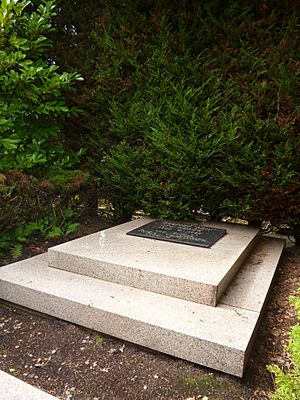
In 1979, Hergé was diagnosed with a blood disease called osteomyelofibrosis. This meant he needed regular blood transfusions.
On February 25, 1983, Hergé had a cardiac arrest (heart attack) and was taken to the hospital in Brussels. He had been planning to meet with Steven Spielberg, who later directed the movie The Adventures of Tintin (2011). Hergé passed away on March 3, 1983. His death was reported on the front pages of many French-language newspapers. In his will, he left everything to his wife, Fanny.
In November 1986, Fanny closed Studios Hergé and created the Hergé Foundation. In 1988, Tintin magazine stopped being published.
Personal life
Hergé was a very private person. On July 20, 1932, he married Germaine Kieckens. They did not have any children. In March 1977, Hergé and Germaine divorced. He later married Fanny Vlamynck; he was 70 years old and she was 42.
Awards and recognition
- 1971: Adamson Awards, Sweden
- 1972: Yellow Kid lifetime award ("a life for cartooning") at the Festival of Lucca
- 1973: Grand Prix Saint Michel of the city of Brussels
- 1999: Included in the Harvey Award Jack Kirby Hall of Fame
- 2003: Included in the Eisner Award Hall of Fame as the Judge's choice
- 2006: The Dalai Lama gave the International Campaign for Tibet's Light of Truth Award to the character of Tintin.
- 2007: Chosen as the main design for a Belgian commemorative coin worth €20 to celebrate his 100th birthday.
According to UNESCO's Index Translationum, Hergé is the ninth most-translated French-language author. He is also the second most-translated Belgian author after Georges Simenon, and the second most-translated French-language comics author after René Goscinny. An asteroid, 1652 Hergé, was named after him in 1953.
Hergé Museum
The Musée Hergé is located in the city of Louvain-la-Neuve, south of Brussels. This location was chosen for the museum in 2001. The modern-looking building was designed by the famous French architect Christian de Portzamparc and cost €15 million to build. The first stone of the museum was laid on May 22, 2007, which was Hergé's 100th birthday. The museum opened in June 2009.
The idea for a museum about Hergé's work started in the late 1970s, when Hergé was still alive. After he passed away in 1983, his widow, Fanny, led the efforts to collect and choose the artwork and items for the museum's exhibits.
The Hergé Museum has eight permanent galleries that show original artwork by Hergé. They tell the story of his life and career, much of which had not been seen by the public before. The museum also has a gallery for temporary exhibitions. While Tintin is a big part of the museum, Hergé's other comic characters, like Jo, Zette and Jocko, and Quick and Flupke, are also featured. His work as a graphic designer is also shown.
Images for kids
See also
 In Spanish: Hergé para niños
In Spanish: Hergé para niños



